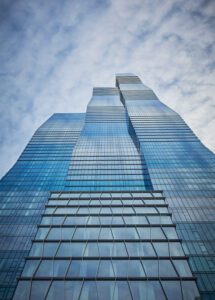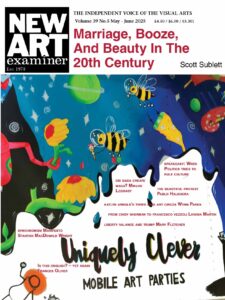
The skyscraper is composed of a modest 12-story volume and three spires of 48, 72, and 101 stories. Photo © Tom Harris, click to enlarge

Studio Gang is a Chicago architecture firm notable for their practice of drawing inspiration from a site’s natural context, which departed from a previous trend to drop a building into a site unaware of that context. The firm’s founder and principal architect, Jeanne Gang, appeared on Time magazine’s list of 100 most influential people for 2019 and previously won the MacArthur genius grant in 2011. Studio Gang’s designs are varied and original, breaking from the architecture tradition of the 20th century in which architects often relied on repeating a signature style independent of context. Gang approaches each new design with a fresh interest in its unique circumstances. As such, she embodies a 21st century movement oriented to sustainability.
Studio Gang was commissioned to design two of four new boathouses for the Chicago River: the WMS boathouse at Clark Park and the Eleanor boathouse at Park 571. Gang’s approach differs drastically from how architects and planners have historically approached building on the river. In the past, the river was seen as a liability. Its legacy of pollution stretched back to the days of the infamous Chicago stock yards when slaughterhouses disposed of offal and carcasses in the river. Subsequently the industrial wastes of the 20th century and today have added to this history. Even with great strides being made in river restoration, architecture and planning has reflected this negative attitude. Buildings turn their backs to the river to hide its presence from people who work and shop there. Roads often dead-end at the river without ever providing the public with physical or even visual access to the water.
Far from the utilitarian structure you might expect under such circumstances, the boathouse’s striking saw tooth roofline stands out from a distance, calling attention to its location and purpose at the edge of the river. The roofline shape is inspired by the motion of oars dipping in and out of the water and the kinetic energy of this motion translates into a dynamic form capable of enticing curiosity and enthusiasm for exploration and recreation on the river. It serves as a landmark for a space and amenity that was previously obscured from public access.
The serrated roof line and zinc and slate-clad façade of the boathouses attract attention and evoke the shimmer of the water, but the true reward is the way the building’s volume is divided into two forms to frame the visitor’s first view of the river. Upon approaching, the river is initially hidden from sight, a visitor enters into a courtyard-like threshold between the two buildings and the view is revealed. In this way the buildings serve as a gateway to the river, presenting a view that dramatizes the experience. This is a design gesture which elevates the river’s status from something to be dismissed or disdained, to something to be celebrated. From the entry courtyard a wide, gently descending staircase made of permeable concrete guides you down to the river’s edge.
The river’s edge is important to the design strategy. Although not part of the building, the space right next to the water is, according to Jeanne Gang, the most interesting place. It is where a visitor can observe change, hear the sound of flowing water and watch animals and fish. This space responds to the changes inevitable with a river. Rather than try to prevent change with a conventional hard wall, the gentle slope of the bank accepts variation in river height. The docks rise and fall with the changing water levels and the permeable concrete is flood-tolerant, allowing rain water to flow back into the river in an uninterrupted natural cycle. Maintaining this hydrologic cycle as close to natural conditions as possible is another way to strengthen the ecological response to the river. Ideally, all development along the river would follow a similar model to support this effort.
On their website Studio Gang asserts: “Ecologically, the overall goal of a healthy river led the design team to focus

on diverting stormwater from the city’s combined sewer system, one of the largest impediments to improved water quality. The boathouse’s roof drainage elements and site design together function as its stormwater management system, diverting 100 percent of runoff from the sewer. Green infrastructure—porous concrete and asphalt, native plantings, gravel beds, and bioswales (rain gardens)—is used to store and filter runoff before slowly releasing this filtered water back into the river. Existing habitats were maintained and strengthened with a mix of native grass, plants, and trees, and silt fabric prevented compaction and erosion during construction. These efforts serve as a model for softening the river’s edge, supporting its ongoing revitalization.”
The interiors of the boathouses also maintain a visual connection with the river, providing ample views of the water. The interior finishes and colors play on the riparian location. Plywood-clad walls evoke ship building and elongated light fixtures reference long oars. These aesthetic cues coupled with direct visual linage ensure that visitors feel embedded in their location and connected to the river. The buildings face the river; one houses the boats and the other offers a field house and exercise rooms. Within the storage building, south-facing windows in the roof provide passive solar heating and natural ventilation and lighting. In fact, the biggest sustainable building strategy of the boathouses is to separate year-round from seasonal uses, thereby reducing the need for mechanical heating and cooling. In this way the spilt volume of the buildings provides a dual function, framing the approach to the water and reducing energy demands.
“It’s impossible to replicate nature—it’s too good,” Jeanne Gang says in a New Yorker profile. “It’s about trying to find that space where it’s art.”
There are few places along the Chicago River where residents can get close enough to touch the water. At the boathouse, the design not only allows direct contact, but encourages this interaction through the choice of a grand staircase and choreographed entry sequence. The design therefore fosters a relationship between the community and the river. This relationship provides the community with a close access to urban nature, while instilling appreciation for the aesthetic and ecological qualities of the river.
As Jeanne Gang summarizes “The Chicago River boathouses are part of a new environmentally friendly vision for the city’s river. By making the riverfront a destination for recreation, anchored by dynamic sustainable architecture, we hope to catalyze long-term stewardship and support for the river’s remediation as well as improve the health of the communities that surround it.”
Although the boathouse does nothing to change the river itself, it does change how the river is understood. A framed river – curated through the lens of cultural importance – allows the Chicago River to take on new value in the lives of visitors and the people who live alongside it
Monica Richart
Volume 34 no 1 September – October 2019 pp 34-36
Monica Richart is a landscape restoration architect who teaches environmental design at Depaul University.

